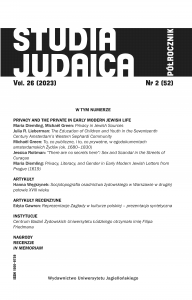Socjotopografia osadnictwa żydowskiego w Warszawie
w drugiej połowie XVIII wieku
Sociotopography of the Jewish Settlement in Warsaw in the Second Half of the Eighteenth Century
Author(s): Hanna WęgrzynekSubject(s): Social history, 18th Century
Published by: Wydawnictwo Uniwersytetu Jagiellońskiego
Keywords: Jewish settlement in Warsaw; population structure; trade; crafts; local government; representation system; eighteenth century;
Summary/Abstract: In the second half of the eighteenth century, there was a rapid influx of Jews to Warsaw, even though at that time the de non tolerandis Iudaeis law was still in force. In 1778, there were over 3,500 Jews in Warsaw, and by 1792 the number increased to 7,000. At that time, they constituted over seven percent of the entire population of the city. Jews lived in different parts of Warsaw, but they began to form enclaves that were centers of both economic and religious life. The activity of the Warsaw Jews was dominated by two fields: trade and crafts. In the 1790s, they accounted for thirty percent of commercial operations. Responding to the needs of the Warsaw market, Jews started producing clothes. About thirty percent of the tailors working in Warsaw were Jewish. Despite numerous restric- tions and bans, Jewish self-government institutions began to emerge in Warsaw, and religious life developed. These changes were conducive, if not to legalization, then to the slow acceptance of the Jewish presence in Warsaw. In this way, at the end of the eighteenth century, not only the largest Jewish community in Europe began to emerge in Warsaw, but also an important center of Jewish social, cul- tural, and religious life.
Journal: Studia Judaica
- Issue Year: 26/2023
- Issue No: 52
- Page Range: 435-457
- Page Count: 23
- Language: Polish

